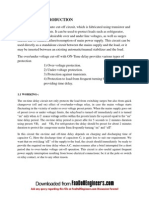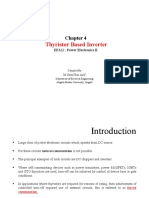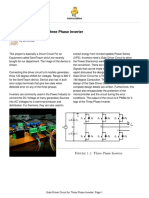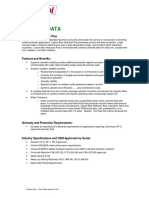Project 2018
Project 2018
Uploaded by
negikrishna9627Copyright:
Available Formats
Project 2018
Project 2018
Uploaded by
negikrishna9627Original Description:
Original Title
Copyright
Available Formats
Share this document
Did you find this document useful?
Is this content inappropriate?
Copyright:
Available Formats
Project 2018
Project 2018
Uploaded by
negikrishna9627Copyright:
Available Formats
See discussions, stats, and author profiles for this publication at: https://www.researchgate.
net/publication/332332621
Fabrication of a MOSFET-based low-cost inverter for domestic purposes
Article · January 2018
CITATIONS READS
0 10,907
2 authors, including:
Kishore Dutta
Handique Girls College, Guwahati, India
46 PUBLICATIONS 118 CITATIONS
SEE PROFILE
All content following this page was uploaded by Kishore Dutta on 10 April 2019.
The user has requested enhancement of the downloaded file.
Bulletin of Physics Projects, 3, 11-13, 2018 ISSN: 2455-9407
Fabrication of a MOSFET-based low-cost inverter for domestic
purposes
Madhubala Baruah, Kishore Dutta#
Department of Physics, Handique Girls’ Guwahati, Assam, India
#
Corresponding author’s e-mail address: kdkishore77@gmail.com
Abstract
We design a low-cost inverter circuit using transistor and MOSFETs motivated by the growing demand due to frequent
power shortages. As an undergraduate laboratory experiment, the circuit constructed from transistors, capacitors,
resistors, and n-channel enhancement MOSFETs works in three stages: astable multivibrator, oscillatory circuit, and step-
up of the voltage. It produces a 50 Hz AC signal which is then fed into a step- up transformer. We find that the circuit
transforms a 12 Volt DC input to a 160 Volt AC output. Higher voltage rating can be achieved by enhancing the stage of
oscillation.
1. Introduction: made in this project to design a low cost inverter circuit
which can generate a sufficient amount of AC voltage for
In today’s technological world, the demand in energy domestic purpose. The branded inverters available in the
consumption, energy saving, explorations of alternative market comprises of ICs, Op-Amps, and 555 timer,
energy sources are growing day by day. Search for making it very expensive. However, without using ICs, a
alternating energy source now-a-days is an open low-cost DC to AC inverter can be designed as done in
challenging problem. Apart from this, due to lack of this project. It comprises only low-cost transistors, n-
sufficient electric power generation, inverter has become a channel enhancement MOSFETs, and a step-up
highly demanding equipment used in every residential and transformer [3, 4].
commercial places [1, 2]. An inverter drives the power from 2. Experimental Details:
DC power banks, like lead acid battery pack. The most The basic idea behind a working inverter circuit is to
common type of inverter we see in everyday life is convert a DC signal to a constant oscillation and apply
uninterruptible power supply (UPS) that are used to keep these oscillatory signals across the primary of a suitable
personal computers running in the event of power cuts. step-up transformer to obtain the desired AC voltage. The
Designing a low cost inverter is therefore a highly circuit that is designed for this purpose thus works in three
demanding challenge which can mitigate the needs of successive steps: (a) astable multivibrator (b) MOSFET-
power for economically weak people during the time of based oscillator circuit and (c) Stepped up the voltage
load shedding. Keeping this in mind, an attempt has been using transformer. The circuit designed in this project work
Bulletin of Physics Projects, 3, 11-13, 2018 ISSN: 2455-9407
is shown schematically in Fig. 1, showing clearly the triggering. The time period of each states are determined by
various components used in the circuit. It requires (a) a the values of the resistors and capacitors used in the circuit.
As shown in Fig. 2, the two transistors are working
together as a switch. When one of the transistors is ON, its
collector and emitter act as a short circuit while in the OFF
mode, they act as an open circuit. In the OFF state, the
collector of the transistor possesses a voltage Vc while in
the ON state, the collector turns out to have zero voltage
(grounded). When the circuit is switched ON, one of the
transistors will be conducting more than the other due to
imbalance in the circuit or difference in the parameters of
the transistor. Finally, depending on the time constant, it
will be driven to saturation (ON) and the less conducting
transistor will be driven to cutoff (OFF). Lets assume that
the transistor Q1 is in ON state and Q2 is in OFF state.
During this time capacitor C2 is charging to Vc through
resistor R. During this time, Q2 remains OFF due to the
negative voltage from the discharging capacitor C1 which is
charged during the previous cycle. Thus, the OFF time of
Q2 is determined by time constant T1 = R1C1. After this
time period, the capacitor C1 discharges completely and
Figure 1: Schematic circuit diagram of the inverter starts charging in reverse direction through R1. The
negative voltage from the capacitor C2 turns OFF the
12V DC Battery (b) a center-tapped 2 Amp step-up transistor Q1 and the capacitor C1 starts charging from Vc
transformer (c) two IRF 630 n-MOSFET (d) two 2N2222 through resistor R and base emitter of transistor Q2 .
transistors (e) two 2.2 µF Capacitors (f) two 680 Ω Thus the transistor Q2 remains in ON state. As in the
resistors and (g) two 12 KΩ resistors. previous state, when the capacitor C2 discharges
2.1. Working Principle behind the circuit completely, it starts charging towards opposite direction
through R2. When the voltage across the capacitor C2 is
sufficient to turn ON transistor Q1, it will turn ON and the
capacitor C1 starts discharging. This process continues and
produces rectangular waves at the collector of each
transistor.
Figure 2: Circuit diagram of astable multivibrator
In the first step of the functioning, there is an astable
Figure 3: Circuit diagram of MOSFET based oscillatory circuit
multivibrator, also known as a free running multivibrator
that possesses no stable states. This is constructed using
In the second step, the signal from the astable
the transistors, capacitors, and resistors, as shown
multivibrator needs to be fed into a circuit that can
separately in Fig. 2. Its output oscillates continuously
generates a constant desired oscillation. We use MOSFET-
between its two unstable states without the aid of external
Bulletin of Physics Projects, 3, 11-13, 2018 ISSN: 2455-9407
based oscillator circuit, as shown in Fig. 3. It comprises amount of AC voltage for emergency. Although in our
two IRF 630 n-MOS. Each n-MOS has three terminals: experiment we obtain a 50Hz, 160 Volt AC output, the
Gate, Drain, and Source. The Gate terminals of the circuit can easily be reconfigured by using more numbers
MOSFETs are connected to a 12 KΩ resistors through a
of MOSFETs and a step-up transformer having high turn’s
2.2 µF capacitor as shown in the diagram. It is also fed by
the collector of each transistors used in the astable ratio so that desired output can be achieved. Since 160
multivibrator circuit. The Source terminals of each Volt is sufficient to glow a number of 20-30 Watt Compact
MOSFET are connected to the Emitter of the transistors to fluorescent lamp (CFL), it can be used effectively in
enhance the frequency produced by the astable domestic purpose in emergency.
multivibrator. Finally, the oscillatory signal generated by 5. Acknowledgement:
the n- MOS is used as an input to the step-up transformer
The authors would like to acknowledge the
by connecting the Drain terminals of each MOSFETs to
the primary coil of a step-up transformer. The center- Department of Physics, Handique Girls’ College for
tapped step-up transformer has a three terminal input with providing scopes for smooth performance of the entire
two extreme terminals connected to the Drains and the project work within stipulated time.
center one is connected to the positive terminal of the
supply voltage (12 Volt DC battery). In fact, it is also 6. References
connected to the collector terminals of the transistors. This
[1] Louis Nashelsky and Robert Boylestad, Electronic devices
way the n-MOS based oscillatory circuit is able to generate
and circuit theory, Pearson, Eleventh Edition (2015)
a high AC voltage having frequency ~50Hz.
[2] Thomas L. Floyd, Digital Fundamentals, Prantice Hall,
3. Results and Discussions:
Ninth Edition (2006)
As shown in Fig. 1, the circuit for the inverter is assembled [3] Electronics Magazine, Electronics Weekly, Circulation-40,
by connecting the circuits for astable multivibrator, n-MOS
918 (2007)
oscillator circuit and the step-up transformer as discussed
[4] Electronics Today International, 20, No. 4 (1990)
above. With this circuitry, the output terminal of the step-
up transformer with its center- tap connected to 12V DC,
is connected to a 220 Volt 60 Watt bulb. When the circuit
is switched on, the bulb glows and we measure the output
AC voltage by using an AC voltmeter and its frequency by
a digital multimeter. We find that the frequency of the AC
signal is f ≈ 50Hz and the output AC voltage is 160 Volt.
The frequency of the oscillator circuit can further be
enhanced by using a series of MOSFETs in succession.
Further, the output AC voltage can be increased by using a
step-up transformer with more turn’s ratio.
Figure 4: The working circuit configuration in the laboratory
4. Conclusions
The circuit designed here is an initial attempt to develop a
low-cost domestic purpose inverter that generates a desired
View publication stats
You might also like
- Switch-Mode Light Dimmer Using MultivibratorsDocument4 pagesSwitch-Mode Light Dimmer Using MultivibratorsCaryl Anne BalbasNo ratings yet
- MC Murray InverterDocument92 pagesMC Murray InverterGnanaseharan Arunachalam100% (5)
- Over-Under Voltage Cut-Off With On-Time Delay PROJECT REPORTDocument35 pagesOver-Under Voltage Cut-Off With On-Time Delay PROJECT REPORTSumit Agarwal80% (5)
- MultivibratorsDocument14 pagesMultivibratorsMuhammadSajidNo ratings yet
- Core JavaDocument11 pagesCore JavaGangadharNo ratings yet
- Rim 2000Document6 pagesRim 2000Senki AlphonsNo ratings yet
- Abad Dominguez Practica06Document22 pagesAbad Dominguez Practica06erick alavaNo ratings yet
- A New Topology of Softswitched Twogwditch Forward Converter andDocument6 pagesA New Topology of Softswitched Twogwditch Forward Converter andGago YesaeanNo ratings yet
- Comparison and Simulation of Full Bridge and LCL-T Buck DC-DC Converter SystemsDocument5 pagesComparison and Simulation of Full Bridge and LCL-T Buck DC-DC Converter SystemsKrishnaveni Subramani SNo ratings yet
- Multivibrators OverviewDocument15 pagesMultivibrators OverviewAchuilNo ratings yet
- Chapter Three System Driver 3.1 MOSFET Control CircuitDocument11 pagesChapter Three System Driver 3.1 MOSFET Control CircuitAlhussain EmbarkNo ratings yet
- Answer Key Power ElectrnicsDocument17 pagesAnswer Key Power ElectrnicsVanchinathan KNo ratings yet
- Thyrister Based InverterDocument31 pagesThyrister Based InverterAbdul Hudaif100% (1)
- AO Report (Theory)Document5 pagesAO Report (Theory)Farwa RaisNo ratings yet
- 10 21205-Deufmd 2020226518-1095964Document11 pages10 21205-Deufmd 2020226518-1095964Ajmal KhanNo ratings yet
- Xia 2013Document4 pagesXia 2013vNo ratings yet
- Astable Multivibrator Using TransistorsDocument10 pagesAstable Multivibrator Using TransistorsGangireddy SanjeevNo ratings yet
- 19MO504-IE 2 MarksDocument40 pages19MO504-IE 2 MarksSaranya. M SNSNo ratings yet
- Unit-IV (24-25)Document99 pagesUnit-IV (24-25)prasatya0706No ratings yet
- DC To Ac Converter by Using 555 Timer ICDocument6 pagesDC To Ac Converter by Using 555 Timer ICAlfred Adukobirre Adukobilla0% (1)
- Ćuk Converter - Wikipedia PDFDocument3 pagesĆuk Converter - Wikipedia PDFAchile SopNo ratings yet
- EEE 4504 Exp - 03Document8 pagesEEE 4504 Exp - 03tanvirsiddique819No ratings yet
- A Multi Vibrator Is An Electronic Circuit Used To Implement A Variety of Simple TwoDocument5 pagesA Multi Vibrator Is An Electronic Circuit Used To Implement A Variety of Simple TwoAgus TriyatmokoNo ratings yet
- Important Question For EEE Viva Exam Prepared By: MD - Mynul Hasan (Prince)Document12 pagesImportant Question For EEE Viva Exam Prepared By: MD - Mynul Hasan (Prince)Mehedi Hasan HemelNo ratings yet
- Design and Implementation of Grid Tied High Step-Up DC-DC Converter With Switched CapacitorDocument12 pagesDesign and Implementation of Grid Tied High Step-Up DC-DC Converter With Switched CapacitorInternational Journal of Power Electronics and Drive SystemsNo ratings yet
- Chap 2Document40 pagesChap 2Adem AbdelaNo ratings yet
- Power Electronics Exam 2017 SolutionsDocument13 pagesPower Electronics Exam 2017 SolutionsBakri BugaNo ratings yet
- Simple Circuits For Power ElectronicsDocument7 pagesSimple Circuits For Power ElectronicsSohira QaziNo ratings yet
- 200 - EE8552, EE6503 Power Electronics - Question Bank 3Document119 pages200 - EE8552, EE6503 Power Electronics - Question Bank 3NiteshNarukaNo ratings yet
- Inverter and ChopperDocument92 pagesInverter and ChopperGnanaseharan ArunachalamNo ratings yet
- EE6503-Power ElectronicsDocument41 pagesEE6503-Power Electronicscwizard60No ratings yet
- Ecd ReportDocument5 pagesEcd ReportFarwa RaisNo ratings yet
- Astable MultivibratorDocument4 pagesAstable MultivibratorDa100% (1)
- A I M S D S: Ms Ramaiah Institute of Technology Dept. of EEEDocument13 pagesA I M S D S: Ms Ramaiah Institute of Technology Dept. of EEEKiran SugandhiNo ratings yet
- Mod 2Document99 pagesMod 2SREEHARI V ANo ratings yet
- Conta Biil I Dad Aula CliDocument7 pagesConta Biil I Dad Aula CliPedroPablo GonzalezNo ratings yet
- EC6304 Electronic Circuits I Question BankDocument10 pagesEC6304 Electronic Circuits I Question BankAnonymous kQZgP8No ratings yet
- Potencia PDFDocument109 pagesPotencia PDFdavidNo ratings yet
- Gate Driver Circuit For Three Phase InverterDocument13 pagesGate Driver Circuit For Three Phase InverterMarc Tcheukaba100% (1)
- 017 BSR-MP WJMS Vol13-No02-Paper05Document10 pages017 BSR-MP WJMS Vol13-No02-Paper05mprabhakar.ped1573No ratings yet
- Rectification. 10 CO2 L3 Sol N.: Maharaja Institute of Technology MysoreDocument7 pagesRectification. 10 CO2 L3 Sol N.: Maharaja Institute of Technology MysoreSpoorthy HUNo ratings yet
- Switched Inductor Based Quadratic ConverterDocument6 pagesSwitched Inductor Based Quadratic ConverterInternational Journal of Innovative Science and Research TechnologyNo ratings yet
- 5KVA Inverter Boost H-BridgeDocument8 pages5KVA Inverter Boost H-BridgeThèm Khát100% (1)
- Buck Boost ConvertersDocument33 pagesBuck Boost ConvertersMuneerAhmed0% (1)
- Multi Vibrato RssDocument6 pagesMulti Vibrato RssRamanujam O SNo ratings yet
- Pulse Circuits - Bistable MultivibratorDocument7 pagesPulse Circuits - Bistable Multivibratorsabbirsafi08No ratings yet
- Presentation Major Project FINALDocument20 pagesPresentation Major Project FINALReena MishraNo ratings yet
- Hid IgniterDocument6 pagesHid IgniterTNo ratings yet
- Force CommutationDocument9 pagesForce Commutationajeet324No ratings yet
- Single Transistor 12V To 230V InverterDocument7 pagesSingle Transistor 12V To 230V Inverteryr48No ratings yet
- Triggering Circuit For Thyristors.: Project ProposalDocument9 pagesTriggering Circuit For Thyristors.: Project Proposalmohsin AwanNo ratings yet
- Unijunction TransistorDocument54 pagesUnijunction TransistorPaoNo ratings yet
- EEE 54 DP2 DocumentationDocument5 pagesEEE 54 DP2 DocumentationDarl John MendozaNo ratings yet
- Analog Circuits and Simulation LabDocument77 pagesAnalog Circuits and Simulation LableevasusanNo ratings yet
- Chapter 4 Wave shaping circuit (2)Document46 pagesChapter 4 Wave shaping circuit (2)murtessaahmed9No ratings yet
- Buckand LdoDocument22 pagesBuckand LdoUğur KeleşNo ratings yet
- Static Relays: Prepared by Ashebir KDocument27 pagesStatic Relays: Prepared by Ashebir KSolomon Tadesse AthlawNo ratings yet
- Assignment 2 PEDocument13 pagesAssignment 2 PEHemkeshNo ratings yet
- Design Fabrication and Performance Analysis of Solar InverterDocument5 pagesDesign Fabrication and Performance Analysis of Solar InverterSyed ZadaaNo ratings yet
- Reference Guide To Useful Electronic Circuits And Circuit Design Techniques - Part 2From EverandReference Guide To Useful Electronic Circuits And Circuit Design Techniques - Part 2No ratings yet
- ISO-24341-2006 - Resilient and Textile Floor Coverings - Determination of Length, Width and Straightness of SheetDocument9 pagesISO-24341-2006 - Resilient and Textile Floor Coverings - Determination of Length, Width and Straightness of SheetsarinurkhsnhNo ratings yet
- Non-Uniform Flow in Open Channels Specific EnergyDocument8 pagesNon-Uniform Flow in Open Channels Specific EnergyWeldon OdhiamboNo ratings yet
- How To Access Online Classes and Paid Materials: PrepinstaDocument11 pagesHow To Access Online Classes and Paid Materials: PrepinstaAkHilkumar BoragalaNo ratings yet
- Arches Vaults and Dome FinalDocument39 pagesArches Vaults and Dome FinalPratima Mahesh0% (1)
- 6 Demirbas (1998)Document12 pages6 Demirbas (1998)No lo leasNo ratings yet
- 115mn0544 Project Report - Ardhagram 8th Sem MidDocument25 pages115mn0544 Project Report - Ardhagram 8th Sem MidPrabhupad PandaNo ratings yet
- BT-148 Manual PDFDocument9 pagesBT-148 Manual PDFVíctor peralesNo ratings yet
- Cor Jesu College, Inc.: College of Education, Arts and SciencesDocument3 pagesCor Jesu College, Inc.: College of Education, Arts and SciencesDashy CatsNo ratings yet
- Employee absenteeism-BANK OF BARODADocument20 pagesEmployee absenteeism-BANK OF BARODABiman MondalNo ratings yet
- Chapter 2Document6 pagesChapter 2WillCanuza100% (1)
- Internship Report ABHiDocument26 pagesInternship Report ABHi[AK] GAMINGNo ratings yet
- LabomDocument4 pagesLabomvyaschiromNo ratings yet
- DLL - English 1 - Q3 - W1Document5 pagesDLL - English 1 - Q3 - W1JOHAIMAH CABUGATANNo ratings yet
- AFA Grade - 7 - W1 - Farm Tools in Horticultural OperationsDocument9 pagesAFA Grade - 7 - W1 - Farm Tools in Horticultural OperationsPaul100% (1)
- SAP Testing Consultant PDFDocument10 pagesSAP Testing Consultant PDFkumard205No ratings yet
- Chapter03 Entity Relationship ModelingDocument59 pagesChapter03 Entity Relationship Modelingbianca09sh57% (7)
- Swagelok Needle ValvesDocument12 pagesSwagelok Needle Valvesnegg 348No ratings yet
- IGCSE Global Perspectives: How Do I Conduct An Independent Research Project?Document11 pagesIGCSE Global Perspectives: How Do I Conduct An Independent Research Project?suzy2pugh2824100% (1)
- Access Audit Proforma CPWDDocument15 pagesAccess Audit Proforma CPWDPrashantNo ratings yet
- Product Data: Castrol Blue Hydraulic PlusDocument3 pagesProduct Data: Castrol Blue Hydraulic PlusGabriel Torres BenturaNo ratings yet
- Assignment III Operations ManagementDocument4 pagesAssignment III Operations ManagementalynahussaincfaNo ratings yet
- Introduction To Development EconomicsDocument31 pagesIntroduction To Development EconomicsI Outdoor GuideNo ratings yet
- Aristotle's Physics (Barnes)Document187 pagesAristotle's Physics (Barnes)Carlos CortésNo ratings yet
- XrevelatorDocument326 pagesXrevelatorBlake GardnerNo ratings yet
- Mission Pluto PassageDocument3 pagesMission Pluto Passageapi-279192630100% (1)
- TO5 Ecfe OutputDocument11 pagesTO5 Ecfe OutputSurojit PaulNo ratings yet
- Panasonic DVD-S33 User ManualDocument24 pagesPanasonic DVD-S33 User Manualcris_43No ratings yet
- Call For Papers - 1st AnnouncementDocument3 pagesCall For Papers - 1st Announcementeliz_kNo ratings yet
- Science q1 w3 Factors Affecting SolubilityDocument20 pagesScience q1 w3 Factors Affecting SolubilityMallen MallenNo ratings yet
- This Study Resource Was: 1. Identify 3 Details You Must Check On An Invoice For Each For The Following Types of GoodsDocument8 pagesThis Study Resource Was: 1. Identify 3 Details You Must Check On An Invoice For Each For The Following Types of GoodsKiran Chowdary KolluriNo ratings yet

























































































